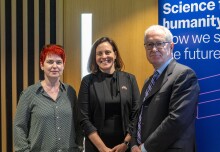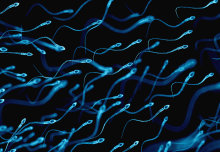

Researchers discover aurora on Saturn unlike the Earth's northern lights<em> - News</em>
See also...
Press release issued by the Science and Technology Facilities Council
For immediate use
Monday 23 June 2008
A UK team of researchers have discovered a secondary aurora sparkling on Saturn and also started to unravel the mechanisms that drive the process. Their results were published in Nature on 19 June 2008, and show that Saturn's secondary aurora is much more like Jupiter's in origin than it is the Earth's.
Aurorae are caused when charged particles stream along the magnetic field of a planet and into its atmosphere. On Earth these charged particles come from the solar wind – a stream of particles that emanates from the Sun. Variations in the Sun control the frequency and intensity of these beautiful displays that can also herald problems – such as interference with satellite communications and power distribution.
The researchers discovered that Saturn's aurora was similar to Jupiter's aurora
On Jupiter however, the dominant source of particles is its own moons, particularly Io which throws out roughly one tonne of volcanic material every second. Some of this becomes ionised (plasma) and is pulled in Jupiter's magnetic field. It co-rotates in a plasma sheet around the planet, but as the particles spread out the magnetic field weakens and this breaks down causing the particles to crash into Jupiter's atmosphere creating an aurora.
On Saturn, whilst one aurora had been observed, the primary source of the particles was unclear. RCUK Academic Fellow Tom Stallard, of the University of Leicester explains: "At Saturn, scientists were unsure whether the aurora was caused by the solar wind or by particles from its own system. When we discovered the second zone of aurorae on Saturn, we realised this aurora, unlike the one already seen on Saturn, was behaving in the same way as Jupiter's, largely unaffected by the solar wind, dominated by the rotation of the planet."
Modelling the aurorae on Jupiter and Saturn shows that both exhibit aurora in the positions where the co-rotation between the planet and its plasma sheet breaks down.
Professor Michele Dougherty from Imperial College London's Department of Physics, said: "These results allow us to better understand the auroral processes taking place at Saturn and confirm results we are finding with the Cassini spacecraft in orbit around the planet; and that is that there are many areas in which the Saturn system mimics the behaviour of Jupiter."
This research is drawn from data collected by NASA's InfraRed Telescope Facility. Saturn's main aurora has been studied using the NASA/ESA Hubble Space Telescope.
The UK researchers have been funded by the Science and Technology Facilities Council, the Engineering & Physical Sciences Research Council and Research Councils UK.
-Ends-
Notes for Editors:
Paper title:
Jovian-like aurorae on Saturn
Authors:
Tom Stallard 1, Steve Miller 2, Henrik Melin 3, Makenzie Lystrup 2, Stan W. H. Cowley 1, Emma J. Bunce 1,Nicholas Achilleos 2 & Michele Dougherty 4
1. Department of Physics and Astronomy, University of Leicester, Leicester LE1 7RH, UK.
2. Atmospheric Physics Laboratory, Department of Physics and Astronomy, University College London, Gower Street, London WC1E 6BT, UK.
3. Space Environment Technologies, Planetary and Space Science Division, 320 N. Halstead Street, Suite 110, Pasadena, California 91107, USA.
4. Space and Atmospheric Physics Group, Department of Physics, Imperial College of Science, Technology and Medicine, London SW7 2BW, UK.
Article text (excluding photos or graphics) available under an Attribution-NonCommercial-ShareAlike Creative Commons license.
Photos and graphics subject to third party copyright used with permission or © Imperial College London.





